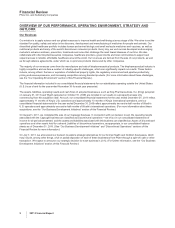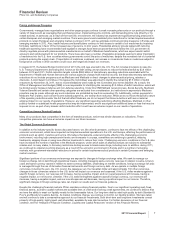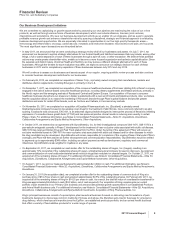Pfizer 2011 Annual Report Download - page 7
Download and view the complete annual report
Please find page 7 of the 2011 Pfizer annual report below. You can navigate through the pages in the report by either clicking on the pages listed below, or by using the keyword search tool below to find specific information within the annual report.
Financial Review
Pfizer Inc. and Subsidiary Companies
•Lipitor in international markets—Lipitor lost exclusivity in Australia in February 2012; in Japan in 2011; and in Brazil, Canada, Spain and
Mexico in 2010; and it has lost exclusivity in nearly all emerging market countries. We do not expect that Lipitor revenues in emerging
markets will be materially impacted over the next several years by the loss of exclusivity. Lipitor will have lost exclusivity in the majority
of European markets by May 2012.
Prior to loss of exclusivity, sales of Lipitor in international markets, except for those in emerging markets, are reported in our
Primary Care business unit. Typically, as of the beginning of the fiscal year following loss of exclusivity, sales of Lipitor in
international markets, except for those in emerging markets, are reported in our Established Products business unit.
•Other loss of exclusivity impacts—In the U.S., we lost exclusivity for Effexor XR in July 2010, for Aricept 5mg and 10mg tablets
(included in Alliance revenue) in November 2010, for Vfend tablets in February 2011, for Xalatan in March 2011 and for Caduet in
November 2011. The basic U.S. patent (including the six-month pediatric exclusivity period) for Protonix expired in January 2011. The
basic patent for Vfend tablets in Brazil expired in January 2011. We lost exclusivity for Aromasin in the U.S. in April 2011 and in the
European Union (EU) in July 2011. We lost exclusivity for Xalatan and Xalacom in 15 major European markets in January 2012. We
lost exclusivity for Aricept in many of the major European markets in February 2012.
In addition, we expect to lose exclusivity for various other products in various markets over the next few years, including the
following in 2012:
•Geodon in the U.S. in March 2012;
•Revatio tablet in the U.S. in September 2012, which reflects the extension of the exclusivity period from March to September 2012 as
the result of a pediatric extension; and
•Detrol IR in the U.S. in September 2012.
For additional information, including with regard to the expiration of the patents for various products in the U.S., EU and Japan, see
the “Patents and Intellectual Property Rights” section of our 2011 Annual Report on Form 10-K.
In Alliance revenues, we expect to be negatively impacted by the following over the next few years.
•Aricept—Our rights to Aricept in Japan will return to Eisai Co., Ltd. in December 2012. We expect to lose exclusivity for the Aricept
23mg tablet in the U.S. in July 2013.
•Spiriva—Our collaboration with Boehringer Ingelheim (BI) for Spiriva will expire on a country-by-country basis between 2012 and 2016.
As a result, we expect to experience a graduated decline in revenues from Spiriva during that period. Our collaboration with BI for
Spiriva will expire in the EU from 2012 and 2016, in 2014 in the U.S. and Japan, and by 2016 in all other countries where the
collaboration exists.
•Enbrel—Our U.S. and Canada collaboration agreement with Amgen Inc. for Enbrel will expire in October 2013. While we are entitled to
royalties for 36 months thereafter, we expect that those royalties will be significantly less than our current share of Enbrel profits from
U.S. and Canada sales. Outside of the U.S. and Canada, our exclusive rights to Enbrel continue in perpetuity.
•Rebif—Our collaboration agreement with EMD Serono Inc. (Serono) to co-promote Rebif in the U.S. will expire either at the end of 2013
or the end of 2015, depending on the outcome of pending litigation between Pfizer and Serono concerning the interpretation of the
agreement. We believe that we are entitled to a 24-month extension of the agreement to the end of 2015. Serono believes that we are
not entitled to the extension and that the agreement will expire at the end of 2013. The lower court ruled in our favor and dismissed
Serono’s complaint, and Serono has appealed the decision. For additional information, see Notes to Consolidated Financial
Statements––Note 17. Commitments and Contingencies.
Pipeline Productivity and Regulatory Environment
The discovery and development of safe, effective new products, as well as the development of additional uses for existing products,
are necessary for the continued strength of our businesses. We are confronted by increasing regulatory scrutiny of drug safety and
efficacy, even as we continue to gather safety and other data on our products, before and after the products have been launched.
Our product lines must be replenished over time in order to offset revenue losses when products lose their exclusivity, as well as to
provide for revenue and earnings growth. We devote considerable resources to research and development (R&D) activities. These
activities involve a high degree of risk and may take many years, and with respect to any specific research and development project,
there can be no assurance that the development of any particular product candidate or new indication for an in-line product will
achieve desired clinical endpoints and safety profile, will be approved by regulators or will be successful commercially. On
February 1, 2011, we announced a new research and productivity initiative to accelerate our strategies to improve innovation and
overall productivity in R&D by prioritizing areas with the greatest scientific and commercial promise, utilizing appropriate risk/return
profiles and focusing on areas with the highest potential to deliver value in the near term and over time.
During the development of a product, we conduct clinical trials to provide data on the drug’s safety and efficacy to support the
evaluation of its overall benefit-risk profile for a particular patient population. In addition, after a product has been approved and
launched, we continue to monitor its safety as long as it is available to patients, and post-marketing trials may be conducted,
including trials requested by regulators and trials that we do voluntarily to gain additional medical knowledge. For the entire life of
the product, we collect safety data and report potential problems to the FDA. The FDA may evaluate potential safety concerns and
take regulatory actions in response, such as updating a product’s labeling, restricting the use of the product, communicating new
safety information to the public, or, in rare cases, removing a product from the market.
6 2011 Financial Report




















